Bulletin – December 2016 Finance Developments in Foreign Exchange and OTC Derivatives Markets
- Download 451KB
Abstract
The Bank for International Settlements (BIS) conducts the Triennial Central Bank Survey of Foreign Exchange and Over-the-counter (OTC) Derivatives Markets Activity (Triennial Survey) to collect information about the size and structure of these markets. The 2016 survey results suggest that global activity in these markets declined since the previous survey, partly reflecting higher-than-usual activity in April 2013 and exchange rate movements. Over the same period, activity in the Australian foreign exchange market declined markedly in US dollar terms, but only modestly in Australian dollar terms. For Australian banks, the value of OTC derivatives outstanding continued to increase, though gross credit exposure declined.
Background
The Triennial Survey provides a comprehensive and unique source of information about the activity and structure of the foreign exchange and OTC derivatives markets. The 2016 survey was undertaken in two parts: the turnover portion measured activity in foreign exchange and OTC single-currency interest rate derivatives markets in the month of April, while the ‘outstandings’ portion measured the amount of OTC derivatives outstanding with reporting dealers as at end June.[1] This article discusses the key results from the Triennial Survey and examines some of the trends in market activity both globally and in Australia. It also provides an overview of developments in the size of OTC derivatives markets as measured by the amounts outstanding, gross market value and gross credit exposure.
Foreign Exchange Turnover
After rising strongly for many years, global foreign exchange turnover declined slightly over the three years to April 2016, to an average of US$5.1 trillion per day (Graph 1).[2] To some extent, this decline in turnover appears to have reflected higher-than-usual activity in April 2013, when the Triennial Survey was previously conducted. The increased activity in April 2013 was primarily in response to the Bank of Japan's (BoJ) decision at that time to expand its asset purchase program substantially (Brooks, Deans, Wallis, Watson and Wyrzykowski 2013). Evidence from semiannual surveys conducted in six of the largest foreign exchange markets suggests that, abstracting from the spike in April 2013, turnover in these markets remained around its average since 2011.[3] In addition, the US dollar appreciated against a range of currencies between April 2013 and April 2016, which reduced the US dollar value of turnover in currencies other than the US dollar; at constant 2016 exchange rates, global foreign exchange turnover increased slightly over this three-year period.
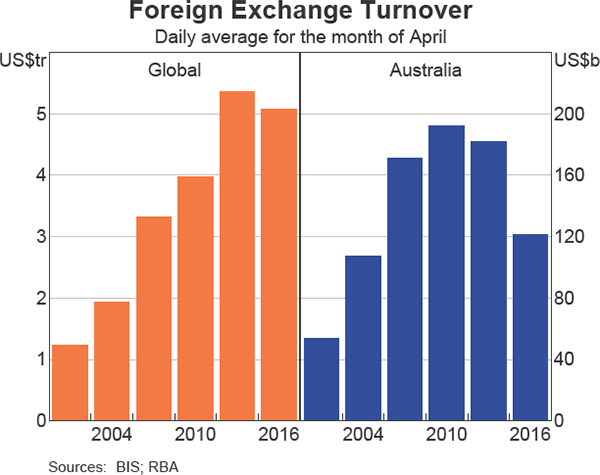
The decline in global turnover over the three years to April 2016 coincided with a 16 per cent decrease in the (US dollar) value of international trade over the same period (Graph 2). While cross-border trade continues to be one of the underlying drivers of foreign exchange turnover, its influence is often limited, especially for advanced highly financialised economies where foreign exchange turnover is significantly larger than gross trade. Global cross-border lending and investment, which are also key sources of demand for foreign exchange transactions, were little changed over the three-year period.
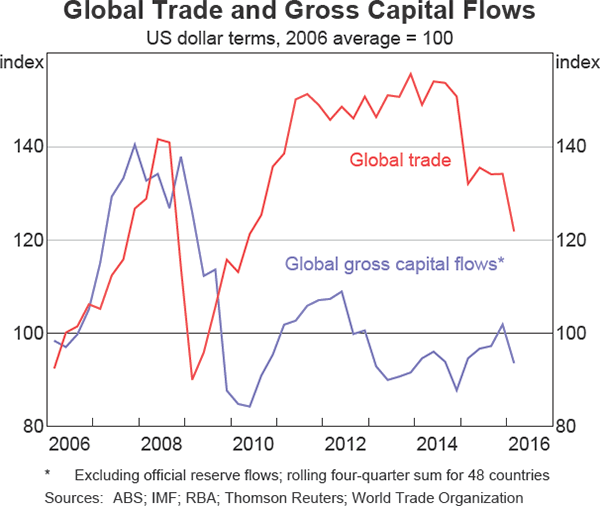
In contrast to the small reduction in global turnover, turnover in the Australian foreign exchange market declined markedly in US dollar terms over the three years to April 2016, to reach a daily average of US$121 billion.[4] The decline in turnover in the Australian foreign exchange market partly reflected a depreciation of the Australian dollar over this period, with a 26 per cent depreciation against the US dollar. Quarterly data collected by the Reserve Bank of Australia and denominated in Australian dollars indicate that activity in the Australian foreign exchange market declined modestly over the three years to April 2016.
Turnover by jurisdiction
The global foreign exchange market continued to become more geographically concentrated in the largest financial centres over the three years to April 2016. The five largest jurisdictions accounted for 77 per cent of global turnover, up from 75 per cent in 2013 (Table 1; Graph 3). Turnover in the United Kingdom declined by around 10 per cent, although the United Kingdom remained the largest foreign exchange centre, accounting for around 37 per cent of global turnover.
| Daily average | Market share | ||
|---|---|---|---|
| April 2016 | April 2013 | April 2016 | |
| USS billion | Per cent | Percent | |
| Total | 5,067 | na | na |
| United Kingdom | 2,406 | 40.8 | 36.9 |
| United States | 1,272 | 18.9 | 19.5 |
| Singapore | 517 | 5.7 | 7.9 |
| Hong Kong | 437 | 4.1 | 6.7 |
| Japan | 399 | 5.6 | 6.1 |
| France | 181 | 2.8 | 2.8 |
| Switzerland | 156 | 3.2 | 2.4 |
| Australia | 121 | 2.7 | 1.9 |
| Other jurisdictions | 1,025 | 16.1 | 15.7 |
|
(a) The sum of jurisdiction subtotals exceeds the global total as jurisdiction subtotals are not adjusted for cross-border double counting; subtotals may not sum to total due to double counting Source: BIS |
|||
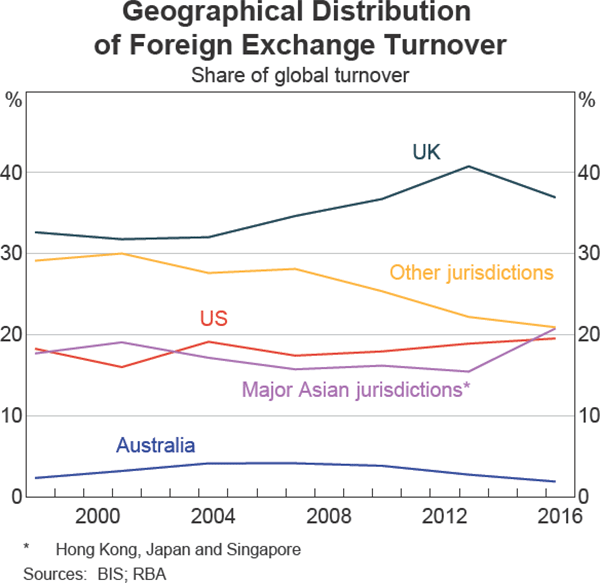
The United States remained the second largest centre, followed by Singapore, Hong Kong and Japan. These four jurisdictions accounted for just over 40 per cent of global turnover, up from around 35 per cent in April 2013. In contrast, turnover declined in the smaller foreign exchange markets of France, Switzerland and Australia. These jurisdictions continued to lose market share, with Switzerland and Australia recording some of the larger declines in the value of turnover among the advanced economies (although, as mentioned above, part of the decline in Australia over the past three years can be accounted for by exchange rate movements). Nonetheless, the Australian foreign exchange market remained the eighth largest in the world.
There was a notable increase in the share of foreign exchange turnover in Asian financial centres over the past three years, alongside an increase in turnover of the Chinese renminbi (RMB) as that currency has become increasingly internationalised. Turnover in Hong Kong increased by nearly 60 per cent and turnover in Singapore and Japan also increased. Collectively, these three jurisdictions accounted for around 20 per cent of global turnover, up from 15 per cent at the time of the previous survey. The strong growth in turnover in Hong Kong and Singapore – a substantial proportion of which is with cross-border reporting dealers – partly contributed to a significant increase in the share of cross-border transactions, which accounted for 65 per cent of global turnover in April 2016.
Turnover by currency
The decline in global foreign exchange turnover was broad based across most of the major currencies (Table 2). An 11 per cent reduction in global turnover of the Japanese yen was driven by significant declines in turnover of the three most actively traded yen currency pairs (USD/JPY, EUR/JPY, and JPY/AUD). These declines may reflect the elevated level of activity denominated in Japanese yen at the time of the 2013 Triennial Survey, in response to the BoJ's decision to expand its asset purchase program. Reflecting the US dollar's role as a global reserve currency, it remains the most traded and liquid currency in the world; it was on one side of 88 per cent of all foreign exchange transactions in April 2016.
| Global | Australia | |||
|---|---|---|---|---|
| Daily average US$ billion | Share of total Per cent | Daily average US$ billion | Share of total Per cent | |
| Total | 5,067 | na | 121 | na |
| Currency(b) | ||||
| USD | 4,438 | 87.6 | 112 | 46.3 |
| EUR | 1,591 | 31.4 | 21 | 8.6 |
| JPY | 1,096 | 21.6 | 18 | 7.2 |
| GBP | 649 | 12.8 | 7 | 2.9 |
| AUD | 348 | 6.9 | 56 | 23.1 |
| RMB(c) | 202 | 4.0 | 2 | 0.9 |
| Other currencies | 1,811 | 35.7 | 26 | 10.9 |
| Currency pair | ||||
| EUR/USD | 1,172 | 23.1 | 18 | 14.6 |
| USD/JPY | 901 | 17.8 | 15 | 12.2 |
| GBP/USD | 470 | 9.3 | 6 | 4.7 |
| AUD/USD | 262 | 5.2 | 49 | 40.7 |
| USD/CAD | 218 | 4.3 | 4 | 3.1 |
| Other currency pairs | 2,044 | 40.3 | 30 | 24.7 |
|
(a) Sub totals may not sum to total due to rounding Sources: BIS; RBA |
||||
Global turnover in the RMB increased by 69 per cent since April 2013, making the RMB the most traded emerging market currency. The RMB was the eighth most traded currency in April 2016, almost doubling its share of global turnover to 4 per cent. The increase was reasonably widespread across markets, and 48 per cent of RMB turnover was recorded outside of Hong Kong and China, up from 44 per cent in 2013, consistent with the ongoing process of internationalising the RMB (Graph 4). RMB-denominated turnover in the Australian market increased notably over the three years to April 2016, but accounts for only a small proportion of total Australian foreign exchange turnover.
Global turnover of the Australian dollar declined by around 25 per cent over the three years to April 2016 measured in US dollar terms. However, at constant (2016) exchange rates, Australian dollar-denominated activity was estimated to be little changed. The decline reflected substantial reductions in turnover in US dollar terms in the three most actively traded Australian dollar currency pairs (AUD/USD, AUD/EUR and AUD/JPY). In geographical terms, turnover of the Australian dollar increased in Singapore and Hong Kong, but declined in the UK. Around three quarters of all Australian dollar activity is conducted offshore. Although it lost market share, the Australian dollar remains the fifth most traded currency and AUD/USD remains the fourth most traded currency pair.
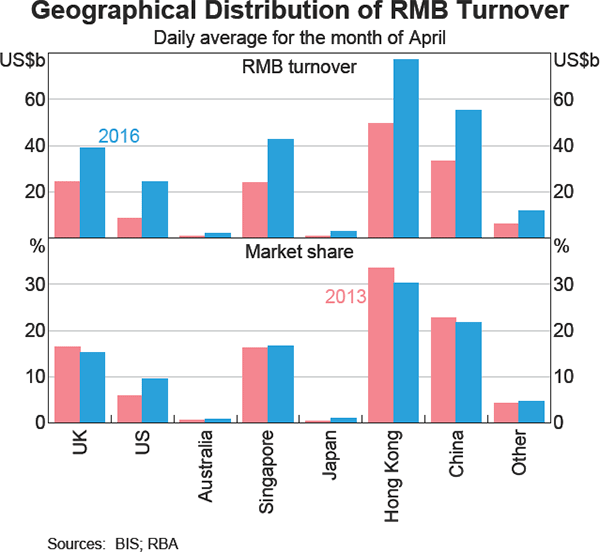
Turnover by counterparty
Reporting dealers in each jurisdiction provide information on their turnover with other reporting dealers (the interdealer market), with other financial institutions, and with non-financial institutions. Over the three years to April 2016, activity between reporting dealers and other financial institutions declined. The decline was partly driven by turnover between reporting dealers and hedge funds and proprietary trading firms, and occurred alongside a decline in the assets under management of hedge funds that pursue currency driven return strategies (Graph 5). The decline was also driven by a reduction in turnover between reporting dealers and non-reporting banks. Activity between reporting dealers and institutional investors (e.g. pension funds) rose over the three-year period.
The share of trading between reporting dealers (i.e. in the interdealer market) grew marginally over the three-year period. This partly reflected the strong growth in turnover in Hong Kong and Singapore, where around 65 per cent of turnover is with cross-border reporting dealers compared with around a third in the United Kingdom and United States. While turnover in the Australian interdealer market declined, this activity accounted for a much larger share of the local market (at around 80 per cent) compared with the global market (at around 40 per cent), and has risen over recent years at the expense of turnover between reporting dealers and other financial institutions.
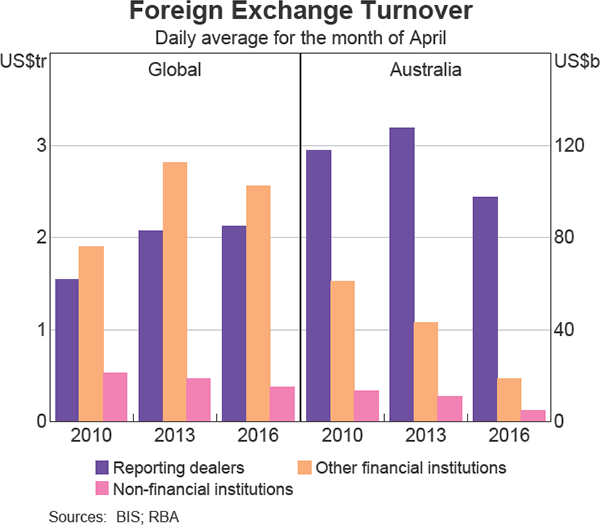
Notwithstanding the growth in interdealer turnover over the three years to April 2016, the observed decline in the share of global foreign exchange turnover conducted in the interdealer market between 1995 and 2013 has been linked to the rise in trade internalisation. This is a process by which reporting dealers offset trade orders from one customer with those from another, thereby allowing dealers to manage their inventory imbalances without having to access the traditional interdealer market. To be considered as internalisation, positions are expected to be held only for a short period – typically a few minutes – until they are offset against a trade order in the opposite direction. Data on internalisation were collected for the first time in the 2016 Triennial Survey, in order to assess the importance of this trend for the evolving structure of global foreign exchange markets.
The results of the survey indicate that spot transactions had the highest internalisation of all foreign exchange instruments. This is expected, given the more standardised nature of these transactions compared with other foreign exchange instruments. In line with this, the Australian internalisation ratio was also highest for spot transactions. Across jurisdictions, internalisation ratios tended to be higher for larger foreign exchange trading centres and where electronic trading is prevalent. Australia's estimated internalisation ratio was around 40 per cent in April 2016, which was broadly in line with the global average.
Global turnover between reporting dealers and non-financial institutions continued to decline over the three years to April 2016. This is consistent with the decline in global trade recorded over this period, which is likely to be a key source of foreign exchange demand from non-financial institutions. The decline in turnover with non-financial institutions was also evident in Australia, with this segment accounting for around 4 per cent of turnover in the domestic market.
Electronic trading methods remained the most popular method for executing foreign exchange trades over the three years to April 2016, both globally and in the Australian market. The share of global activity executed via single bank trading platforms and other electronic communication networks (such as multi-bank electronic trading platforms) increased over the three-year period, while the share of traditional multilateral trading platforms, such as Reuters Matching and EBS, declined. In contrast to the global results, Australian turnover conducted electronically via single bank platforms declined notably over the three years to April 2016, and may have reflected the exit of some large foreign banks from the domestic foreign exchange market.
Estimates of the amount of activity that occurs via dark pools – private platforms for trading securities where access is restricted and prices are not revealed – were collected for the first time in the 2016 Triennial Survey. These data indicate that dark pools accounted for only a small share of global and Australian foreign exchange market activity.
Turnover by instrument
Turnover of foreign exchange swaps continued to increase over the three-year period, and accounted for 47 per cent of global foreign exchange turnover in April 2016. The increase was broad based across most currencies, with turnover of foreign exchange swaps denominated in Japanese yen increasing notably, and occurred alongside an increase in cross-border turnover of foreign exchange swaps between reporting dealers and between reporting dealers and other financial institutions (in particular, institutional investors). These results are consistent with increased use of these instruments by Japanese investors to hedge their foreign currency exposures, resulting in part from ongoing purchases of foreign equities and bonds. Global turnover in spot transactions declined by 19 per cent over the three-year period, alongside a decline in global trade, and accounted for 33 per cent of all global foreign exchange activity in April 2016 (Graph 6).
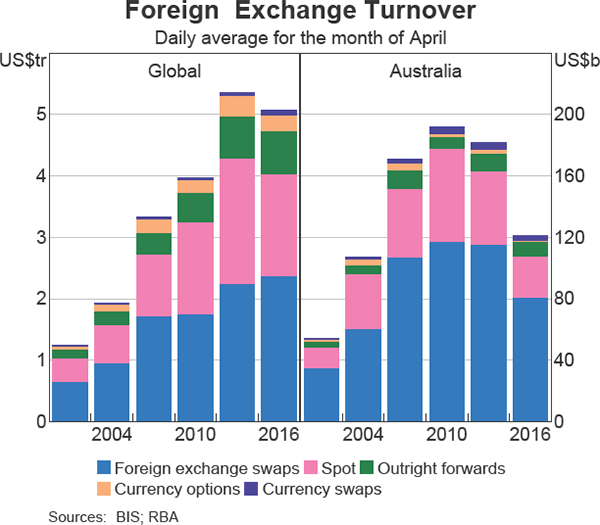
In contrast to the global results, turnover of foreign exchange swaps in the Australian market declined in US dollar terms. This largely reflected the 26 per cent depreciation of the Australian dollar against the US dollar over the three-year period. Almost half of all foreign exchange swaps in the domestic market involved the Australian dollar and a majority of these were against the US dollar.
Turnover in cross-currency swaps in the Australian market also declined over the three years to April 2016, and Australia's share of the global cross-currency swap market declined accordingly. This result largely reflects the depreciation of the Australian dollar against the US dollar over the period; in Australian dollar terms, activity in this market declined only a little. Australian financial institutions issue around two-thirds of their bonds offshore and typically use cross-currency swaps to hedge the foreign exchange exposures associated with this borrowing. The decline in Australian activity in these instruments over the three-year period is in contrast to Australian banks' foreign currency-denominated bond issuance, which increased over the three years to April 2016. This is also in contrast to the small increase in the notional amount of these instruments outstanding with Australian banks (see below), and could be due to an increase in the average maturity of new bond issuance and also methodological differences between the turnover and the outstanding portions of the Triennial Survey.
Single-currency interest rate OTC derivatives turnover
Over the three years to April 2016, average daily global turnover in single currency OTC interest rate derivatives increased by around 15 per cent to US$2.7 trillion (Graph 7).[5] The increase in US dollar-denominated activity was particularly strong, with these instruments accounting for around half of total turnover in single-currency OTC interest rate derivatives. In contrast, turnover in euro-denominated instruments declined considerably, and could partly reflect a 13 per cent depreciation of the euro against the US dollar over the period.

Global turnover of Australian dollar-denominated interest rate derivatives continued to increase, with the share of global turnover accounted for by Australian dollar-denominated interest rate derivatives rising to around 5 per cent. However, turnover of Australian dollar-denominated instruments in the Australian market declined – the first such decline since 2001.
In the Australian market, turnover of interest rate derivatives declined over the three years to April 2016, primarily driven by a decline in turnover of forward rate agreements. This could reflect market participants moving away from OTC forward rate agreements and towards centrally cleared alternatives (such as certain types of OTC interest rate swaps) to maximise the netting benefits, including the associated lower capital required when centrally clearing such activity.
The Size of OTC Derivatives Markets
Over the three years to June 2016, most measures indicate that global OTC derivatives markets have contracted. However, due to sharp movements in the UK pound and Japanese yen around the time of the survey, the market value of open contracts increased slightly. While some measures suggest that OTC derivatives held by Australian banks increased, the underlying credit risk associated with outstanding exposures has fallen. There are three different measures of market size included in the survey: the notional amount outstanding, the gross market value and the gross credit exposure.
The gross notional amount outstanding reflects the principal amounts used to calculate payments made on derivatives contracts. The notional amount of global OTC derivatives outstanding has contracted since 2013 (Graph 8). Much of the decline in the size of global OTC derivatives was due to trade compression, particularly for interest rate derivatives, which involves the consolidation of similar derivatives contracts into smaller trades and acts to reduce the number of offsetting positions.[6] In contrast, the notional amount outstanding with Australian dealers continues to grow strongly, increasing by 26 per cent from 2013, led by growth in OTC interest rate derivatives.[7],[8] Relative to other jurisdictions, the use of trade compression by the Australian banks has been less extensive, particularly for Australian dollar-denominated instruments (Reserve Bank of Australia (RBA) 2016).
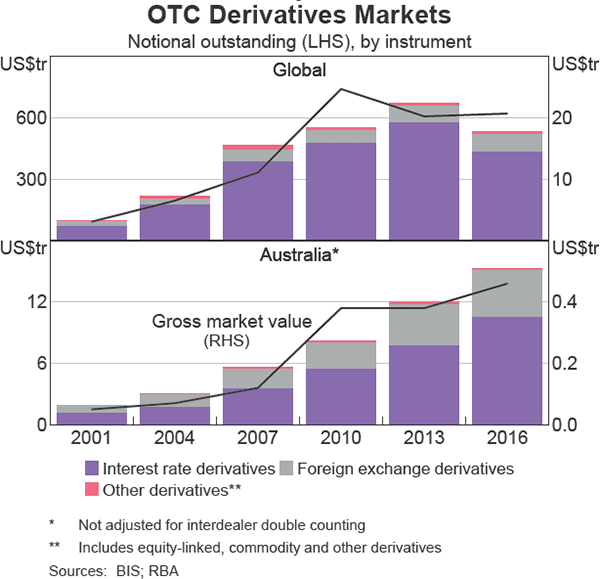
The gross market value outstanding measures the cost that a counterparty would face if all open contracts were to be replaced on the survey date. This measure reflects both the quantity of derivatives outstanding and changes in the market value of the underlying reference variables (e.g. interest rates, exchange rates) between the start of the contract and the survey reporting date. The gross market value therefore shows changes in the value of a contract and is only a small proportion of the contract's notional value. In contrast to the notional amount outstanding, the gross market value of derivatives outstanding increased slightly in global markets over the three years to June 2016, largely due to an increase in the gross market value of foreign exchange derivatives (see below). The gross market value of derivatives held with Australian reporting dealers also increased over the three years to June 2016.
Both the notional amount outstanding and gross market value measures include the value of economically offsetting positions between counterparties. As such, while these measures capture overall market activity, they may not accurately gauge market or counterparty credit risk. These risks are better captured by the gross credit exposure measure, which excludes the value of offsetting positions (such as those covered by bilateral netting arrangements, which legally enforce the consolidation of offsetting positions across all derivative instruments) and provides an aggregate measure of net exposures.[9] Gross credit exposures declined across global markets in the three years to June 2016. For Australian reporting dealers, the gross credit exposure fell to US$135 billion, which is around 30 per cent of the gross market value.
While the majority of outstanding OTC derivatives contracts, both globally and with Australian banks, are single-currency interest rate derivatives, their relative share of the OTC derivatives market has fallen due to increased trade compression alongside the central clearing of these instruments. As a result, foreign exchange derivatives now comprise 16 per cent of global OTC derivatives markets, compared with 12 per cent in 2013. Foreign currency derivatives form a sizeable share of the Australian banks' OTC derivatives, in part due to their use of foreign currency instruments to hedge the exposures on their foreign currency borrowings.[10] In contrast, commodity, equity linked and other derivatives contracts form a very small share of both Australian and global OTC derivatives markets.
Single-currency interest rate OTC derivatives
Globally, the notional amount outstanding of single-currency interest rate OTC derivatives declined substantially over the three years to June 2016, driven by a 47 per cent fall in the notional amounts of euro-denominated contracts (Graph 9). In contrast, the notional amount of single-currency interest rate derivatives held by Australian dealers increased by 35 per cent. The increase was driven by Australian, US and New Zealand dollar-denominated interest rate derivative contracts. The value of contracts outstanding with Australian banks that are denominated in New Zealand dollars was larger than US dollar-denominated contracts in the most recent Triennial Survey. The growth in New Zealand dollar instruments partly reflects an increase in New Zealand dollar funding by the major Australian banks, which all have sizeable New Zealand subsidiaries.[11]
Globally, the vast majority of interest rate derivatives were traded between reporting dealers and other financial institutions (including central counterparties (CCPs)). Data on OTC derivatives traded between reporting dealers and CCPs were separately identified for the first time in the 2016 survey and indicated the majority of interest rate derivatives are now traded between reporting dealers and CCPs, both globally and for Australian banks (Graph 10).[12] For more than a decade, Australian entities had mostly traded OTC interest rate derivatives with other reporting dealers, but this business has shifted towards CCPs as a result of regulatory changes that mandate the use of CCPs for OTC interest rate derivatives denominated in major currencies.[13]
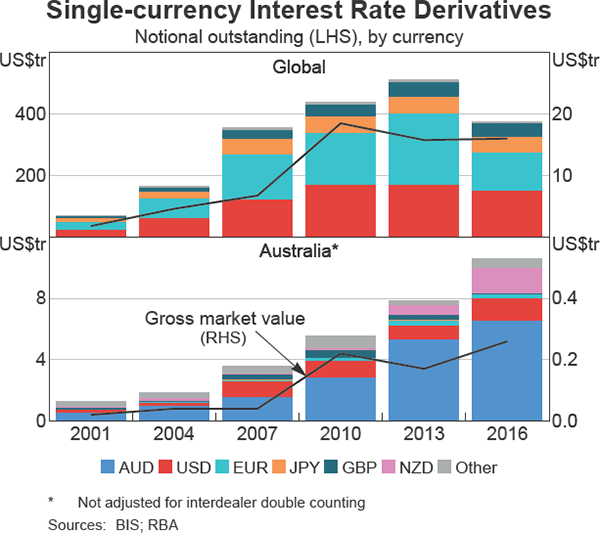
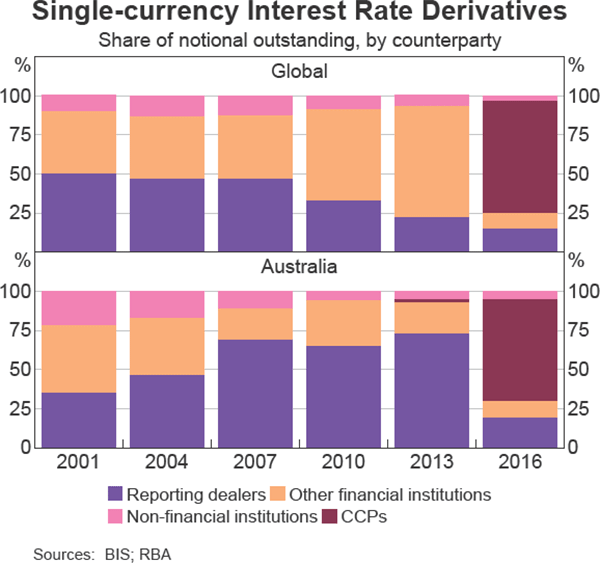
Foreign exchange OTC derivatives
The notional amounts of global foreign exchange derivatives increased by 6 per cent over the three years to June 2016 (Graph 11). The gross market value of foreign exchange derivatives also increased, partly due to the sharp moves noted earlier in the UK pound and Japanese yen around the time of the survey, which increased the market value of contracts denominated in these instruments. The notional amount outstanding reported by Australian dealers continued to grow, increasing by 13 per cent over the three years to June 2016. Nonetheless, the gross market value of foreign exchange derivatives held by Australian dealers declined. In contrast to the global data, Australian dealers have a smaller share of outstanding contracts denominated in the UK pound and Japanese yen, with most trades involving the Australian and US dollars.
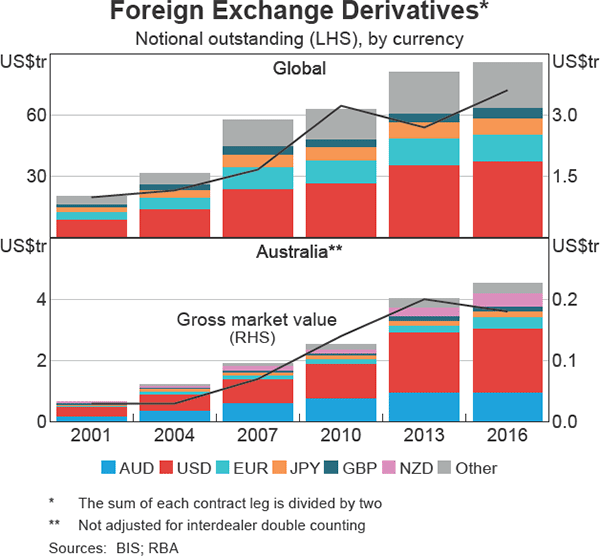
Globally, the increase in foreign exchange derivatives was reflected in a rise in UK pound and US dollar-denominated contracts and instruments issued in ‘other’ currencies.[14] Growth in the notional amounts outstanding with Australian banks was reflected in foreign exchange derivatives denominated in a range of other currencies, in particular the New Zealand, Singapore and Hong Kong dollars. The increase in foreign exchange derivatives may have been in part driven by the hedging activity of the major banks, which have substantially increased issuance in these currencies since June 2013.
The notional amount outstanding of forwards and foreign exchange swaps rose by 18 per cent globally, with those reported by Australian banks increasing by 26 per cent over the three years to June 2016. Forwards and foreign exchange swaps continued to form the largest share of foreign exchange derivatives held by reporting dealers both globally and in Australia (Graph 12). Australian dealers' notional amount outstanding of cross-currency swaps, which differ from foreign exchange swaps as they involve a stream of interest payments in addition to the exchange of principal, increased by 6 per cent since June 2013. Since 2007, currency swaps have comprised an increasingly large share of Australian dealers' foreign exchange derivatives, accounting for 40 per cent of the notional value outstanding in June 2016. This reflects the extensive use of these instruments as a hedging tool for foreign currency-denominated debt issued by the major banks (Arsov et al 2013). Options only represented a small share of foreign exchange derivatives held by Australian banks, but comprised around 15 per cent of the global market.
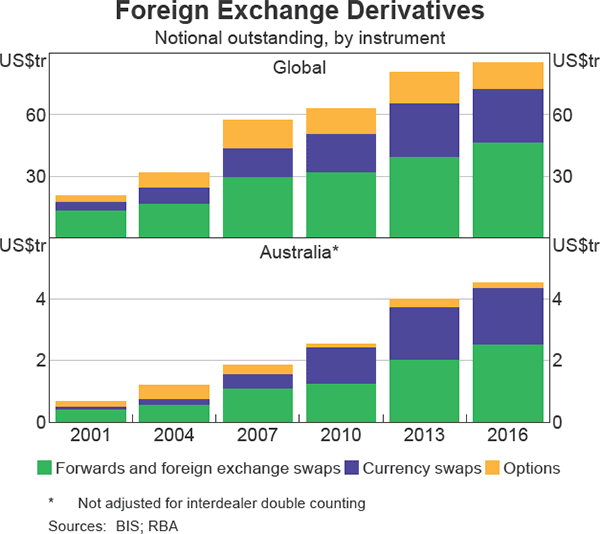
Credit default swaps
The notional amount of credit default swaps (CDS) outstanding held by reporting dealers fell by more than 50 per cent both globally and in Australia over the three years to June 2016 (Graph 13). While globally most CDS reference a single entity, the majority of CDS in Australia reference multiple entities by indexing a tradable basket of CDS contracts. The Australian market is also considerably more concentrated than global markets, with more than 80 per cent of the notional amount outstanding held between reporting dealers, compared with just under 45 per cent for global markets. The ongoing decline in the global and Australian CDS markets may reflect continued use of trade compression to reduce offsetting positions.
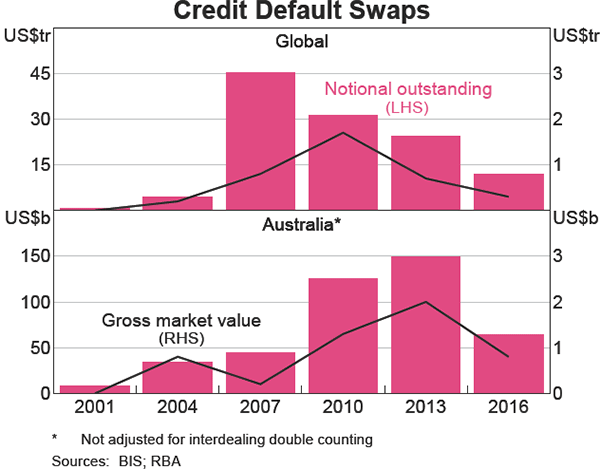
Conclusion
Turnover in global foreign exchange markets declined slightly in US dollar terms over the three years to April 2016, although turnover increased a little once account is taken for the effect of exchange rate movements. The share of foreign exchange turnover in Asian financial centres increased noticeably over the three-year period, alongside a rise in RMB-denominated turnover. While activity in the Australian foreign exchange market declined modestly in Australian dollar terms, the Australian foreign exchange market remained the eighth largest in the world and the Australian dollar the fifth most traded currency.
According to most measures of market size, global OTC derivatives markets contracted over the three years to June 2016, with single-currency OTC interest derivatives accounting for most of this decline. However, due to sharp movements in the UK pound and Japense yen around the time of the survey, the gross market value of global OTC contracts outstanding increased slightly. For Australian reporting dealers, both the notional amount and gross market value of OTC derivatives outstanding continued to increase, while gross credit exposure declined.
Footnotes
The authors are from Financial Markets Group. [*]
The turnover portion of the Triennial Survey was conducted by central banks and other authorities across 52 jurisdictions, and included 24 Australian reporting dealers. Data collected are based on the location in which the trade is booked. The outstandings portion covered 46 jurisdictions and included responses for the consolidated operations of 6 large Australian banks. [1]
Unless otherwise stated, global turnover figures are at current exchange rates and adjusted for interdealer double counting at both the local and global level. Country subtotals are adjusted for interdealer double counting at the local level only. [2]
Semiannual surveys are conducted by central banks and other authorities in Australia, Canada, Japan, Singapore, the United Kingdom and the United States. These jurisdictions now account for around 80 per cent of the global foreign exchange market. However the results are not directly comparable to the Triennial Survey due to some differences in the collection and attribution of turnover. Australia's results for the semiannual survey are available on the Australian Foreign Exchange Committee website at <http://www.rba.gov.au/afxc/statistics/fx-turnover-reports/>. Quarterly data for the Australian market are also available at <http://www.rba.gov.au/statistics/tables/> (Statistical Tables F9 and F10). [3]
The Australian turnover data contain a series break in April 2016; all growth rates discussed with reference to the Australian market are break adjusted. [4]
Single-currency OTC interest rate derivatives include forward rate agreements, swaps and options. [5]
The increase in trade compression has been supported by increased clearing of certain instruments (in particular interest rate swaps) through central counterparties. Banks have an incentive to undertake trade compression to reduce the capital they require to meet the Basel III leverage ratio. [6]
This increase was partly offset by the 20 per cent depreciation in the Australian dollar relative to the US dollar between the June 2013 and 2016 Triennial surveys, which lowered the US dollar value of Australian dollar contracts (OTC derivative positions are reported in US dollars). A constant exchange rate would have translated into an estimated 57 per cent increase in outstanding positions. [7]
For the OTC derivatives outstanding component of the survey, BIS reporting banks disclose the value of their transactions with all other reporting banks globally, but do not separately identify the value of transactions conducted with reporting banks within the home jurisdiction. As a result, the notional amounts outstanding between Australian reporting dealers are counted twice, whereas this double counting is removed by the BIS at a global level, by halving the aggregate outstandings between reporting banks. The Australian data will therefore be somewhat overstated relative to the global data; however, this double counting is likely to be small as transaction level data indicate that most of the Australian banks' derivative trades are conducted with non-Australian banks. [8]
The difference between gross credit exposures and the notional amount outstanding (or the gross market value) may be smaller than it would have otherwise been due to the increasing use of trade compression, which acts to reduce the number of offsetting positions captured in the notional amounts outstanding and gross market value. [9]
Australian banks hedge virtually all of their foreign currency liabilities using derivatives. For further information, see Rush, Sadeghian and Wright (2013). [10]
The Australian banks' increased use of New Zealand dollar funding in recent years appears to have led to higher demand for New Zealand dollar-denominated interest rate derivatives to hedge the associated interest rate risk. [11]
The number of trades with other financial institutions in the global data (including CCPs) in 2013 was exaggerated because when contracts are cleared through CCPs, one trade between reporting dealers becomes two outstanding contracts. [12]
A considerable proportion of trades from Australian dealers moved to CCPs over recent years ahead of the domestic implementation of mandatory central clearing of OTC interest rate derivatives denominated in major currencies and the Australian dollar in April 2016. This excludes Australian dollar overnight indexed swaps, for which mandatory clearing requirements were introduced in October 2016, and forward rate agreements, which will be subject to mandatory clearing requirements from April 2018. Prior to this, some trades were subject to overseas mandatory clearing requirements. In addition, banks face higher capital requirements for OTC derivatives that are not centrally cleared. For more information see Edey (2015). [13]
The BIS does not provide a breakdown of the ‘other’ currencies category. [14]
References
Arsov I, G Moran, B Shanahan and K Stacey (2013), ‘OTC Derivatives Reforms and the Australian Cross-Currency Swap Market’, RBA Bulletin, June, pp 55–63.
Brooks M, C Deans, P Wallis, B Watson and M Wyrzykowski (2013), ‘Developments in Foreign Exchange and OTC Derivatives Markets’, RBA Bulletin, December, pp 59–70.
Edey M (2015), ‘The Transition to Central Clearing of OTC Derivatives in Australia’, International Swaps and Derivatives Association's 2015 Annual Australia Conference, Sydney, 22 October.
RBA (2016), ‘Box D: Trade Compression’, Financial Stability Review, April, pp 49–50.
Rush A, D Sadeghian and M Wright (2013), ‘Foreign Currency Exposure and Hedging in Australia’, RBA Bulletin, December, pp 49–57.